Abstract
Socioeconomic status (SES) is frequently implicated as a contributor to the disparate health observed among racial/ ethnic minorities, women and elderly populations. Findings from studies that examine the role of SES and health disparities, however, have provided inconsistent results. This is due in part to the: 1) lack of precision and reliability of measures; 2) difficulty with the collection of individual SES data; 3) the dynamic nature of SES over a lifetime; 4) the classification of women, children, retired and unemployed persons; 5) lack of or poor correlation between individual SES measures; and 6) and inaccurate or misleading interpretation of study results. Choosing the best variable or approach for measuring SES is dependent in part on its relevance to the population and outcomes under study. Many of the commonly used compositional and contextual SES measures are limited in terms of their usefulness for examining the effect of SES on outcomes in analyses of data that include population subgroups known to experience health disparities. This article describes SES measures, strengths and limitations of specific approaches and methodological issues related to the analysis and interpretation of studies that examine SES and health disparities.
Full text
PDF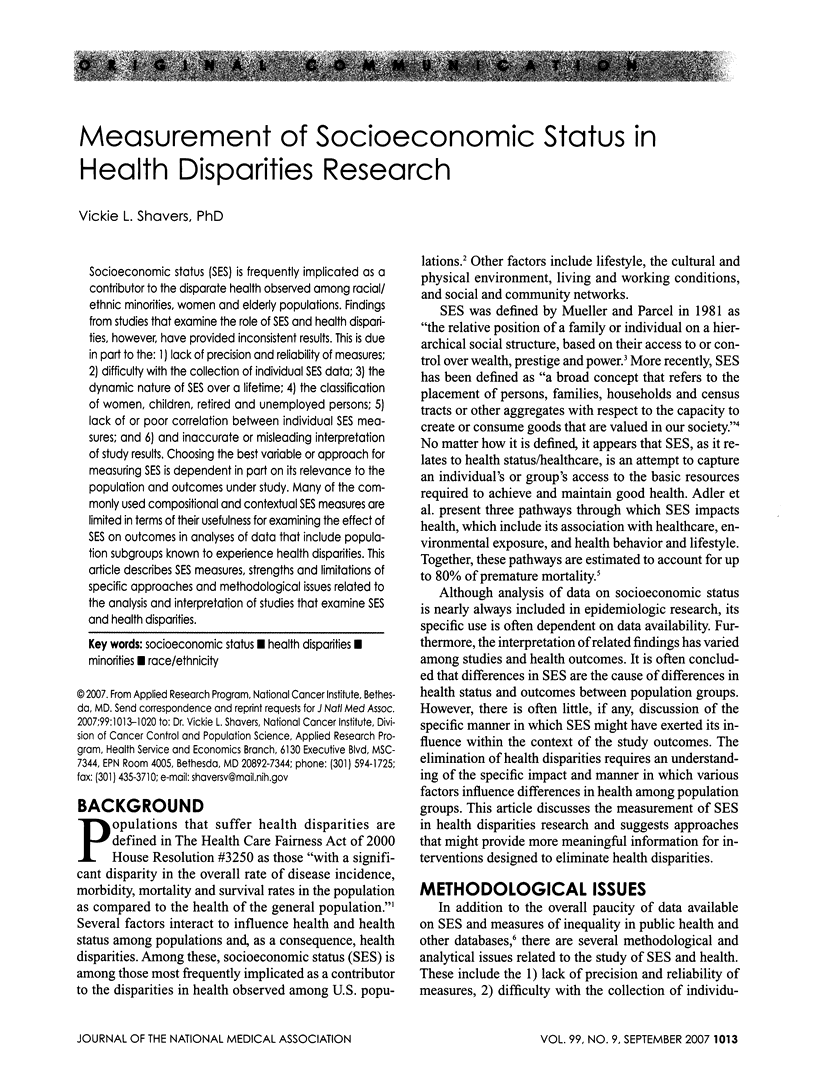
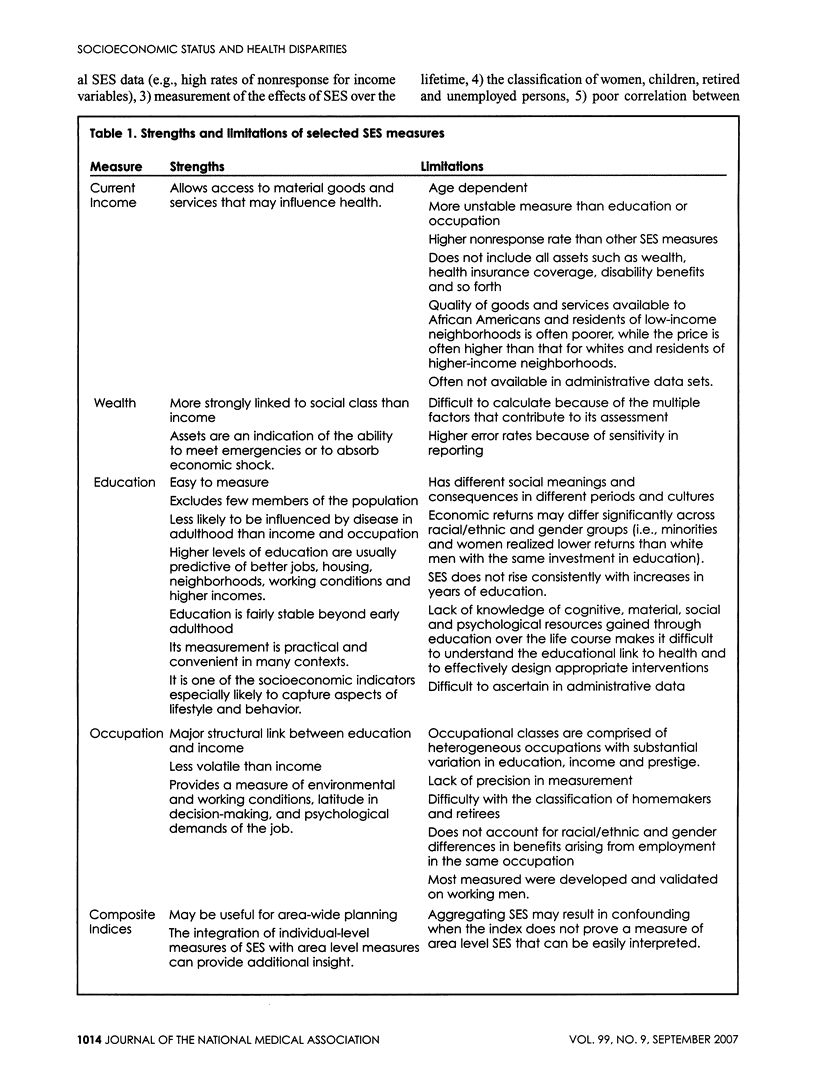
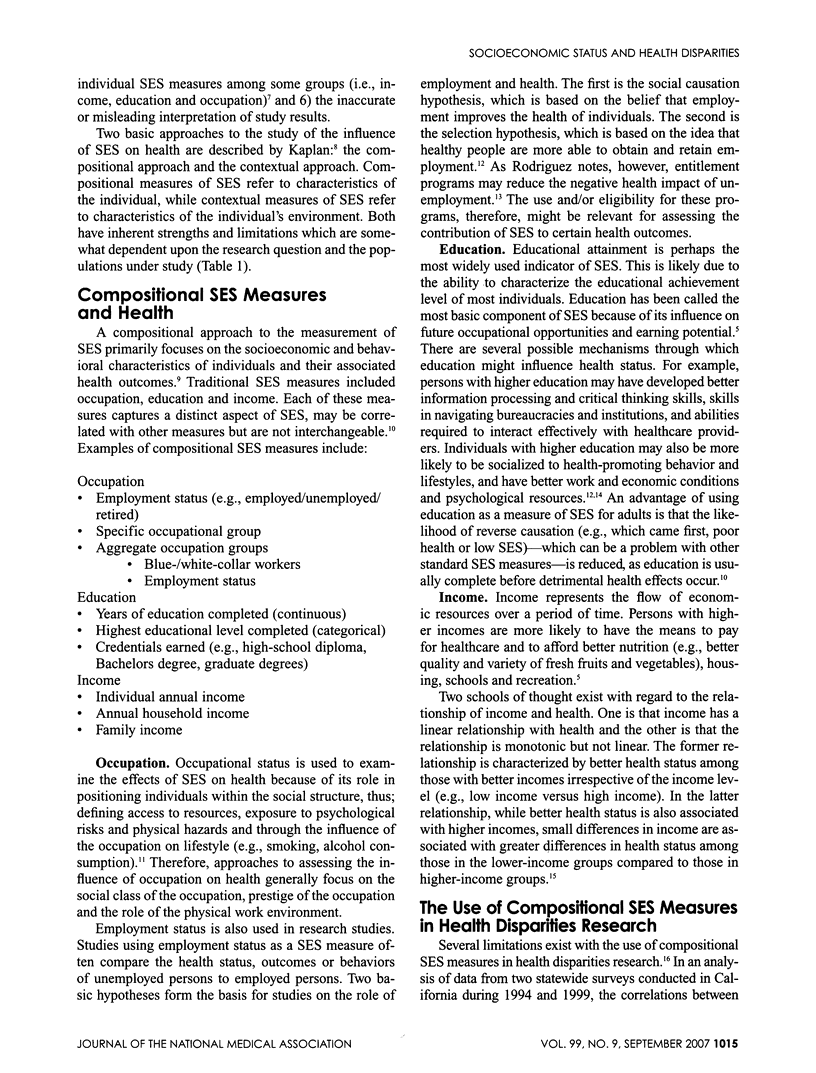
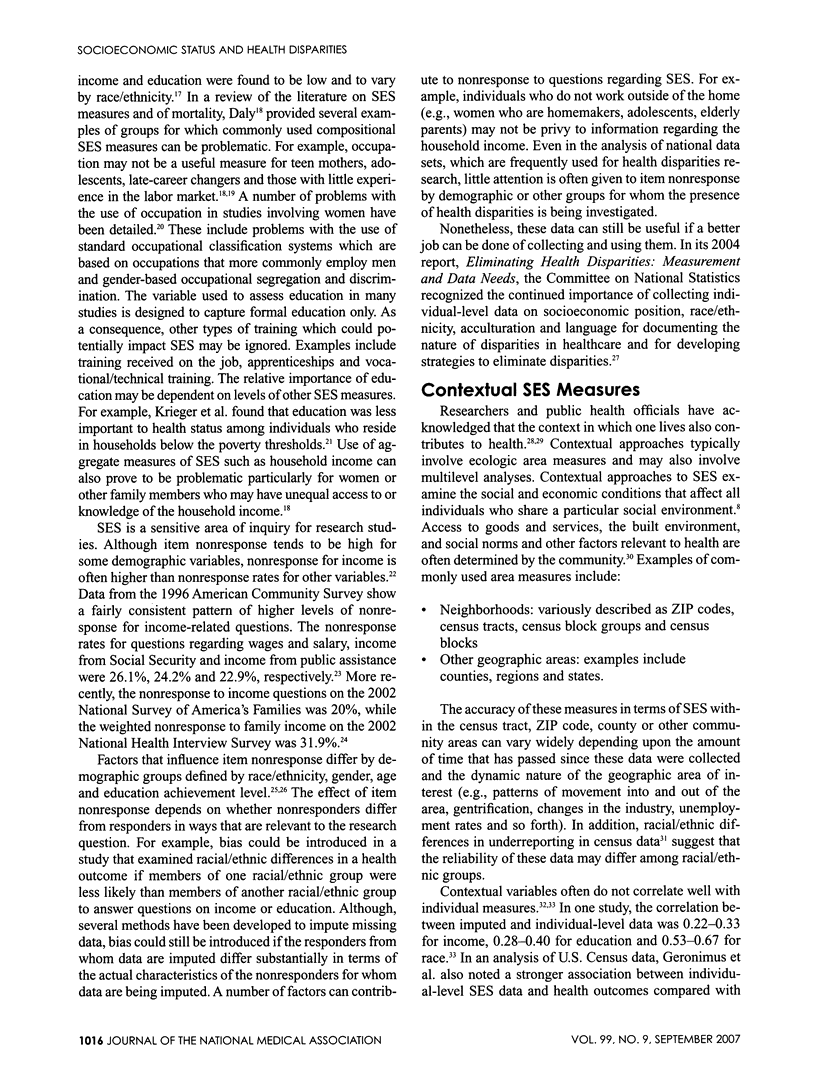
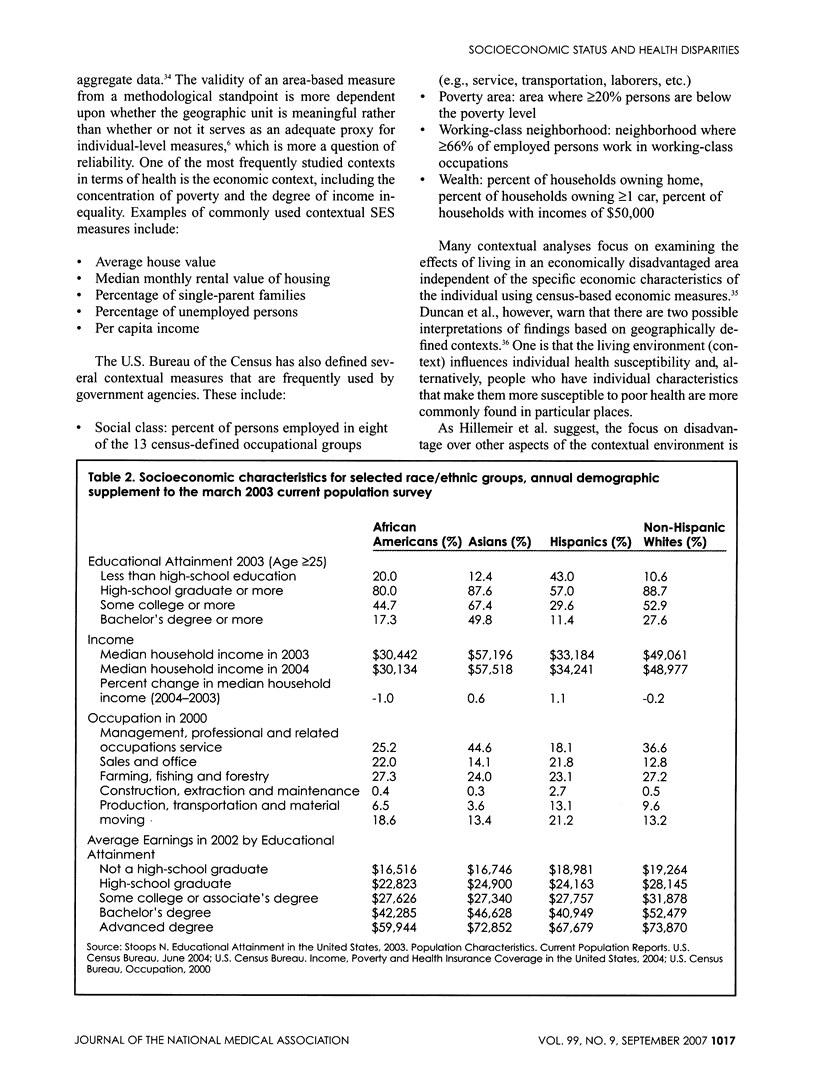
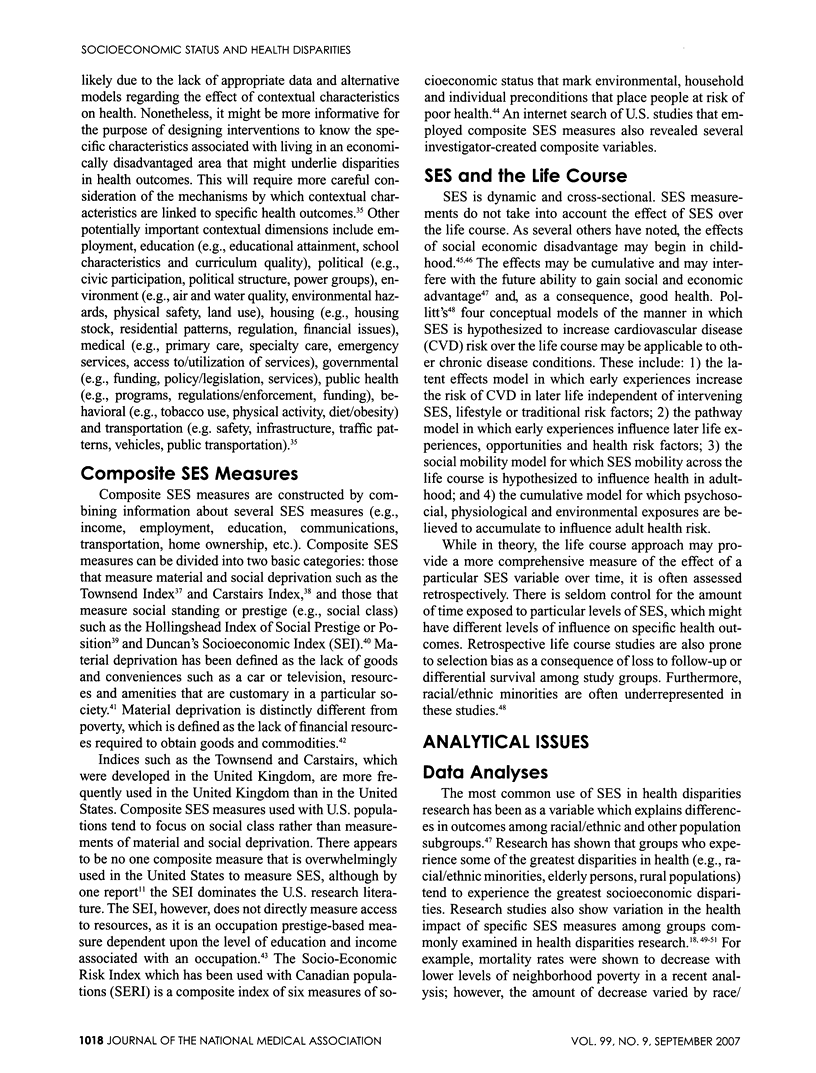
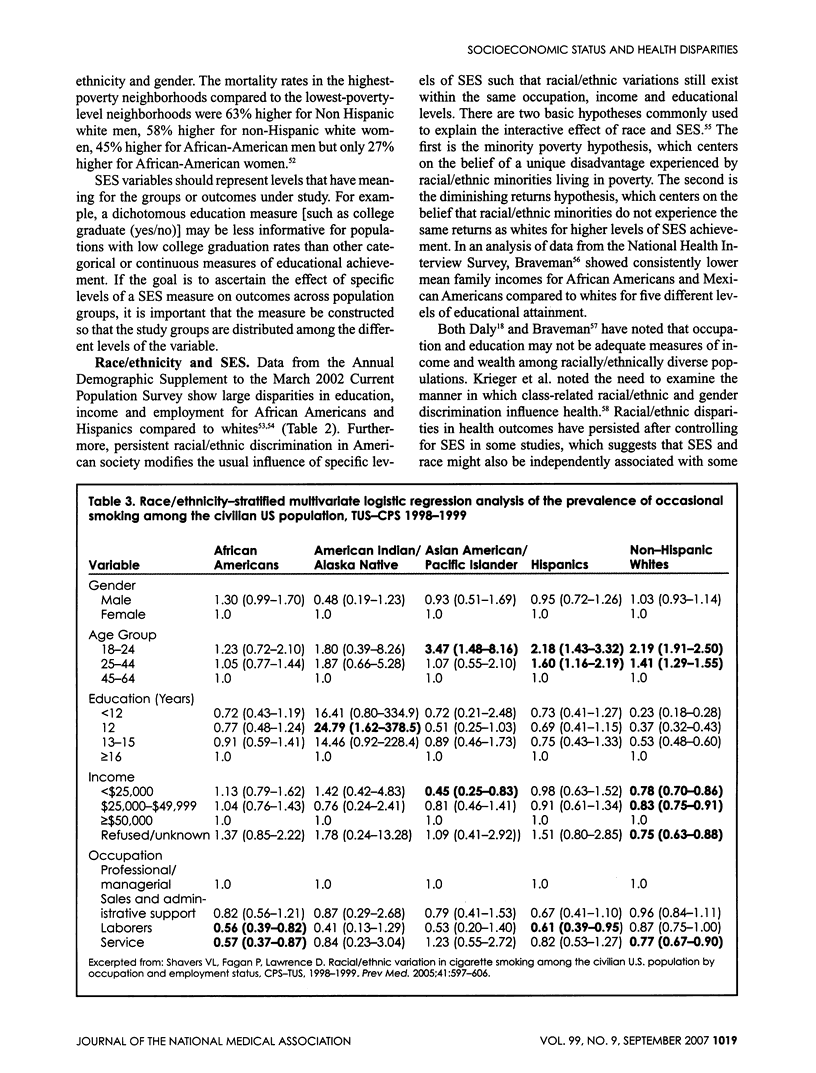
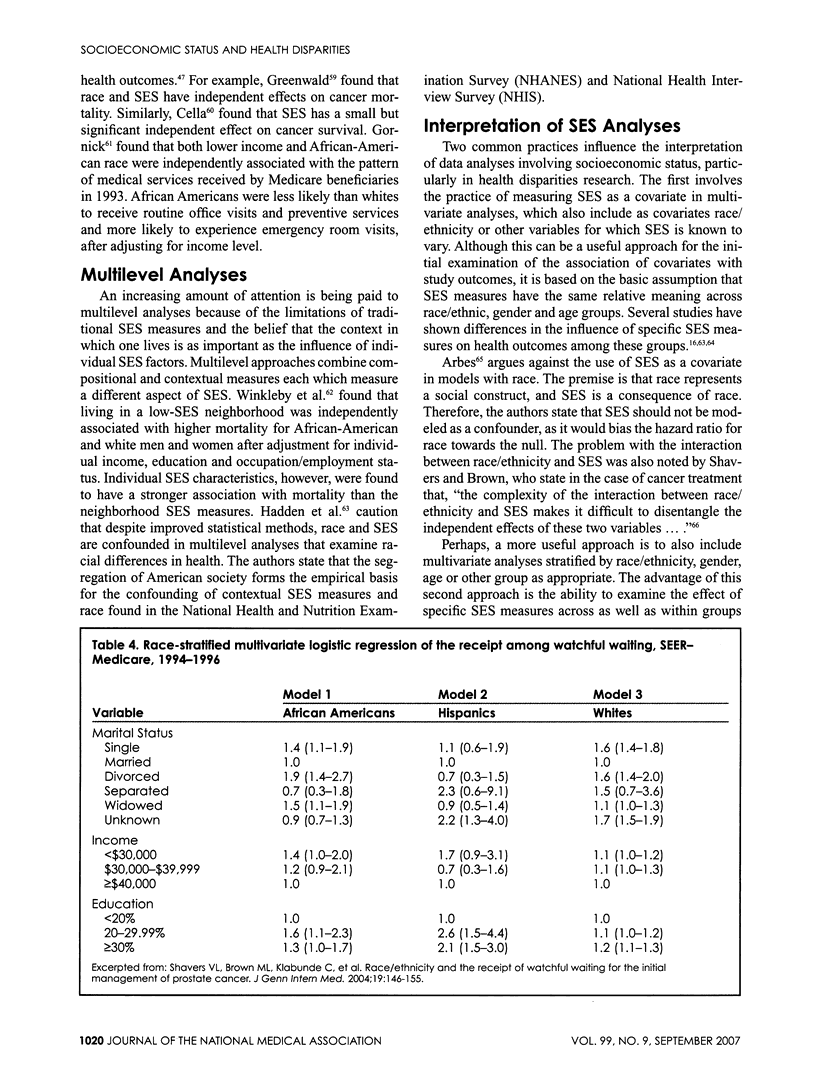
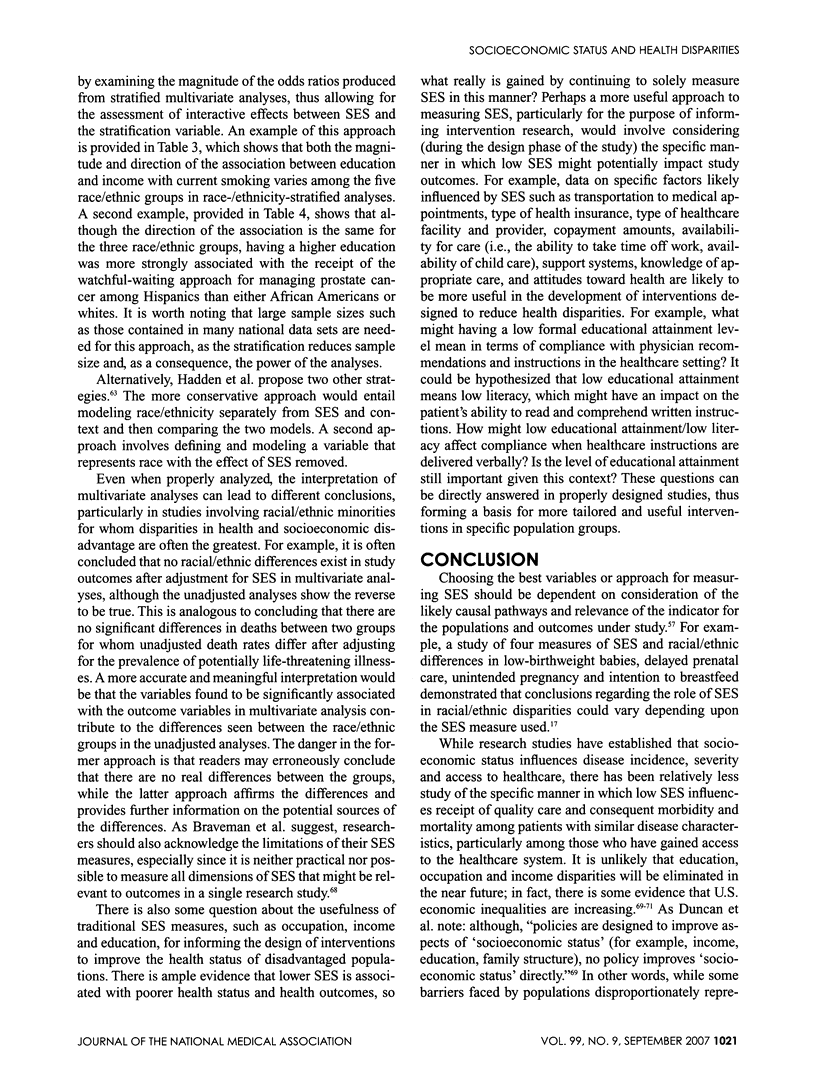
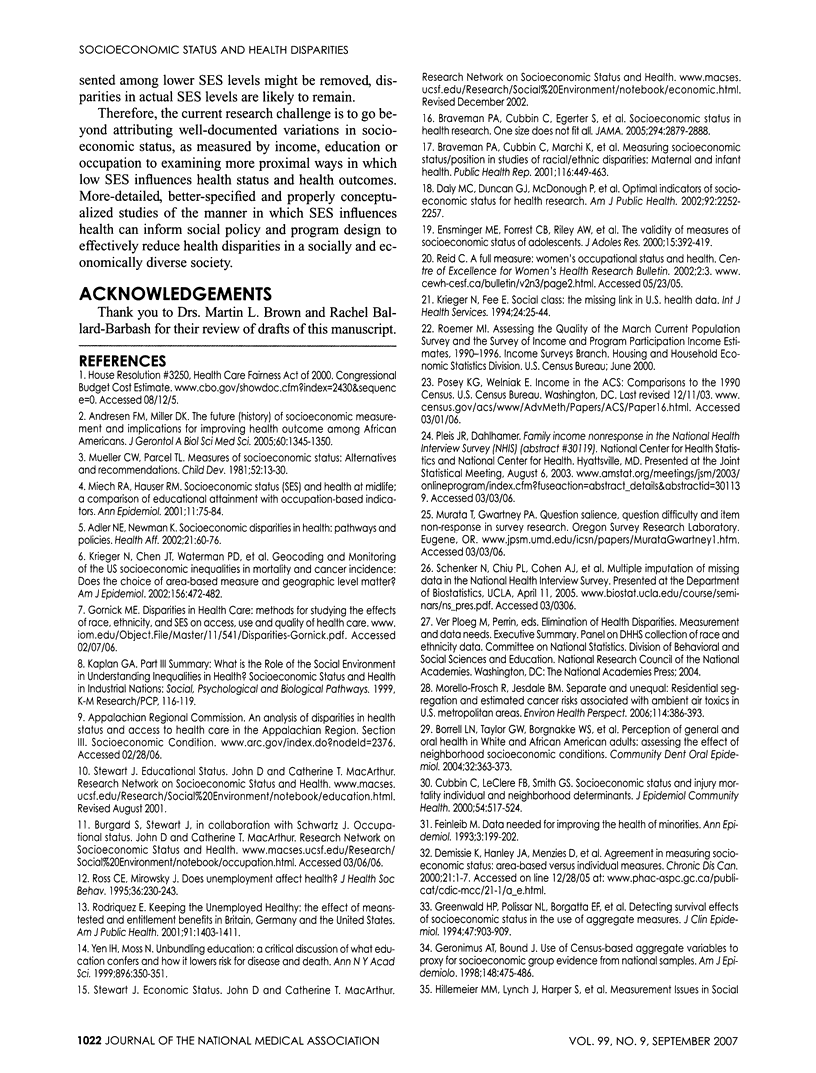

Selected References
These references are in PubMed. This may not be the complete list of references from this article.
- Adler Nancy E., Newman Katherine. Socioeconomic disparities in health: pathways and policies. Health Aff (Millwood) 2002 Mar-Apr;21(2):60–76. doi: 10.1377/hlthaff.21.2.60. [DOI] [PubMed] [Google Scholar]
- Andresen Elena M., Miller Douglas K. The future (history) of socioeconomic measurement and implications for improving health outcomes among African Americans. J Gerontol A Biol Sci Med Sci. 2005 Oct;60(10):1345–1350. doi: 10.1093/gerona/60.10.1345. [DOI] [PubMed] [Google Scholar]
- Arbes S. J., Jr, Olshan A. F., Caplan D. J., Schoenbach V. J., Slade G. D., Symons M. J. Factors contributing to the poorer survival of black Americans diagnosed with oral cancer (United States). Cancer Causes Control. 1999 Dec;10(6):513–523. doi: 10.1023/a:1008911300100. [DOI] [PubMed] [Google Scholar]
- Borrell Luisa N., Taylor George W., Borgnakke Wenche S., Woolfolk Marilyn W., Nyquist Linda V. Perception of general and oral health in White and African American adults: assessing the effect of neighborhood socioeconomic conditions. Community Dent Oral Epidemiol. 2004 Oct;32(5):363–373. doi: 10.1111/j.1600-0528.2004.00177.x. [DOI] [PubMed] [Google Scholar]
- Braveman P., Cubbin C., Marchi K., Egerter S., Chavez G. Measuring socioeconomic status/position in studies of racial/ethnic disparities: maternal and infant health. Public Health Rep. 2001 Sep-Oct;116(5):449–463. doi: 10.1093/phr/116.5.449. [DOI] [PMC free article] [PubMed] [Google Scholar]
- Braveman Paula A., Cubbin Catherine, Egerter Susan, Chideya Sekai, Marchi Kristen S., Metzler Marilyn, Posner Samuel. Socioeconomic status in health research: one size does not fit all. JAMA. 2005 Dec 14;294(22):2879–2888. doi: 10.1001/jama.294.22.2879. [DOI] [PubMed] [Google Scholar]
- Braveman Paula, Cubbin Catherine. Optimal SES indicators cannot be prescribed across all outcomes. Am J Public Health. 2003 Jan;93(1):12–13. doi: 10.2105/ajph.93.1.12-a. [DOI] [PMC free article] [PubMed] [Google Scholar]
- Carstairs V., Morris R. Deprivation: explaining differences in mortality between Scotland and England and Wales. BMJ. 1989 Oct 7;299(6704):886–889. doi: 10.1136/bmj.299.6704.886. [DOI] [PMC free article] [PubMed] [Google Scholar]
- Cella D. F., Orav E. J., Kornblith A. B., Holland J. C., Silberfarb P. M., Lee K. W., Comis R. L., Perry M., Cooper R., Maurer L. H. Socioeconomic status and cancer survival. J Clin Oncol. 1991 Aug;9(8):1500–1509. doi: 10.1200/JCO.1991.9.8.1500. [DOI] [PubMed] [Google Scholar]
- Cubbin C., LeClere F. B., Smith G. S. Socioeconomic status and injury mortality: individual and neighbourhood determinants. J Epidemiol Community Health. 2000 Jul;54(7):517–524. doi: 10.1136/jech.54.7.517. [DOI] [PMC free article] [PubMed] [Google Scholar]
- Demissie K., Hanley J. A., Menzies D., Joseph L., Ernst P. Agreement in measuring socio-economic status: area-based versus individual measures. Chronic Dis Can. 2000;21(1):1–7. [PubMed] [Google Scholar]
- Duncan C., Jones K., Moon G. Context, composition and heterogeneity: using multilevel models in health research. Soc Sci Med. 1998 Jan;46(1):97–117. doi: 10.1016/s0277-9536(97)00148-2. [DOI] [PubMed] [Google Scholar]
- Farmer Melissa M., Ferraro Kenneth F. Are racial disparities in health conditional on socioeconomic status? Soc Sci Med. 2005 Jan;60(1):191–204. doi: 10.1016/j.socscimed.2004.04.026. [DOI] [PubMed] [Google Scholar]
- Feinleib M. Data needed for improving the health of minorities. Ann Epidemiol. 1993 Mar;3(2):199–202. doi: 10.1016/1047-2797(93)90138-t. [DOI] [PubMed] [Google Scholar]
- Geronimus A. T., Bound J. Use of census-based aggregate variables to proxy for socioeconomic group: evidence from national samples. Am J Epidemiol. 1998 Sep 1;148(5):475–486. doi: 10.1093/oxfordjournals.aje.a009673. [DOI] [PubMed] [Google Scholar]
- Gornick M. E. The association of race/socioeconomic status and use of Medicare services. A little-known failure in access to care. Ann N Y Acad Sci. 1999;896:497–500. doi: 10.1111/j.1749-6632.1999.tb08180.x. [DOI] [PubMed] [Google Scholar]
- Greenwald H. P., Polissar N. L., Borgatta E. F., McCorkle R. Detecting survival effects of socioeconomic status: problems in the use of aggregate measures. J Clin Epidemiol. 1994 Aug;47(8):903–909. doi: 10.1016/0895-4356(94)90194-5. [DOI] [PubMed] [Google Scholar]
- Greenwald H. P., Polissar N. L., Dayal H. H. Race, socioeconomic status and survival in three female cancers. Ethn Health. 1996 Mar;1(1):65–75. doi: 10.1080/13557858.1996.9961771. [DOI] [PubMed] [Google Scholar]
- Kahn Joan R., Fazio Elena M. Economic status over the life course and racial disparities in health. J Gerontol B Psychol Sci Soc Sci. 2005 Oct;60(SPEC):76–84. doi: 10.1093/geronb/60.special_issue_2.s76. [DOI] [PubMed] [Google Scholar]
- Kaplan G. A. What is the role of the social environment in understanding inequalities in health? Ann N Y Acad Sci. 1999;896:116–119. doi: 10.1111/j.1749-6632.1999.tb08109.x. [DOI] [PubMed] [Google Scholar]
- Kim Catherine, Eby Elizabeth, Piette John D. Is education associated with mortality for breast cancer and cardiovascular disease among black and white women? Gend Med. 2005 Mar;2(1):13–18. doi: 10.1016/s1550-8579(05)80005-1. [DOI] [PubMed] [Google Scholar]
- Krieger N., Fee E. Social class: the missing link in U.S. health data. Int J Health Serv. 1994;24(1):25–44. doi: 10.2190/2JG7-YMD5-WCP2-XXNT. [DOI] [PubMed] [Google Scholar]
- Krieger N., Williams D. R., Moss N. E. Measuring social class in US public health research: concepts, methodologies, and guidelines. Annu Rev Public Health. 1997;18:341–378. doi: 10.1146/annurev.publhealth.18.1.341. [DOI] [PubMed] [Google Scholar]
- Krieger Nancy, Chen Jarvis T., Waterman Pamela D., Soobader Mah-Jabeen, Subramanian S. V., Carson Rosa. Geocoding and monitoring of US socioeconomic inequalities in mortality and cancer incidence: does the choice of area-based measure and geographic level matter?: the Public Health Disparities Geocoding Project. Am J Epidemiol. 2002 Sep 1;156(5):471–482. doi: 10.1093/aje/kwf068. [DOI] [PubMed] [Google Scholar]
- Luo Ye, Waite Linda J. The impact of childhood and adult SES on physical, mental, and cognitive well-being in later life. J Gerontol B Psychol Sci Soc Sci. 2005 Mar;60(2):S93–S101. doi: 10.1093/geronb/60.2.s93. [DOI] [PMC free article] [PubMed] [Google Scholar]
- Miech R. A., Hauser R. M. Socioeconomic status and health at midlife. A comparison of educational attainment with occupation-based indicators. Ann Epidemiol. 2001 Feb;11(2):75–84. doi: 10.1016/s1047-2797(00)00079-x. [DOI] [PubMed] [Google Scholar]
- Morello-Frosch Rachel, Jesdale Bill M. Separate and unequal: residential segregation and estimated cancer risks associated with ambient air toxics in U.S. metropolitan areas. Environ Health Perspect. 2006 Mar;114(3):386–393. doi: 10.1289/ehp.8500. [DOI] [PMC free article] [PubMed] [Google Scholar]
- Mutchler J. E., Burr J. A. Racial differences in health and health care service utilization in later life: the effect of socioeconomic status. J Health Soc Behav. 1991 Dec;32(4):342–356. [PubMed] [Google Scholar]
- Pampalon R., Raymond G. A deprivation index for health and welfare planning in Quebec. Chronic Dis Can. 2000;21(3):104–113. [PubMed] [Google Scholar]
- Pollitt Ricardo A., Rose Kathryn M., Kaufman Jay S. Evaluating the evidence for models of life course socioeconomic factors and cardiovascular outcomes: a systematic review. BMC Public Health. 2005 Jan 20;5:7–7. doi: 10.1186/1471-2458-5-7. [DOI] [PMC free article] [PubMed] [Google Scholar]
- Robbins Jessica M., Webb David A. Neighborhood poverty, mortality rates, and excess deaths among African Americans: Philadelphia 1999-2001. J Health Care Poor Underserved. 2004 Nov;15(4):530–537. doi: 10.1353/hpu.2004.0072. [DOI] [PubMed] [Google Scholar]
- Robert S., House J. S. SES differentials in health by age and alternative indicators of SES. J Aging Health. 1996 Aug;8(3):359–388. doi: 10.1177/089826439600800304. [DOI] [PubMed] [Google Scholar]
- Rodriguez E. Keeping the unemployed healthy: the effect of means-tested and entitlement benefits in Britain, Germany, and the United States. Am J Public Health. 2001 Sep;91(9):1403–1411. doi: 10.2105/ajph.91.9.1403. [DOI] [PMC free article] [PubMed] [Google Scholar]
- Ross C. E., Mirowsky J. Does employment affect health? J Health Soc Behav. 1995 Sep;36(3):230–243. [PubMed] [Google Scholar]
- Shavers Vickie L., Brown Martin L., Potosky Arnold L., Klabunde Carrie N., Davis W. W., Moul Judd W., Fahey Angela. Race/ethnicity and the receipt of watchful waiting for the initial management of prostate cancer. J Gen Intern Med. 2004 Feb;19(2):146–155. doi: 10.1111/j.1525-1497.2004.30209.x. [DOI] [PMC free article] [PubMed] [Google Scholar]
- Shavers Vickie L., Brown Martin L. Racial and ethnic disparities in the receipt of cancer treatment. J Natl Cancer Inst. 2002 Mar 6;94(5):334–357. doi: 10.1093/jnci/94.5.334. [DOI] [PubMed] [Google Scholar]
- Shavers Vickie L., Lawrence Deirdre, Fagan Pebbles, Gibson James T. Racial/ethnic variation in cigarette smoking among the civilian US population by occupation and industry, TUS-CPS 1998-1999. Prev Med. 2005 Aug;41(2):597–606. doi: 10.1016/j.ypmed.2004.12.004. [DOI] [PubMed] [Google Scholar]
- Stjärne Maria K., Ponce de Leon Antonio, Hallqvist Johan. Contextual effects of social fragmentation and material deprivation on risk of myocardial infarction--results from the Stockholm Heart Epidemiology Program (SHEEP). Int J Epidemiol. 2004 May 20;33(4):732–741. doi: 10.1093/ije/dyh087. [DOI] [PubMed] [Google Scholar]
- Winkleby M. A., Cubbin C. Influence of individual and neighbourhood socioeconomic status on mortality among black, Mexican-American, and white women and men in the United States. J Epidemiol Community Health. 2003 Jun;57(6):444–452. doi: 10.1136/jech.57.6.444. [DOI] [PMC free article] [PubMed] [Google Scholar]
- Yen I. H., Moss N. Unbundling education: a critical discussion of what education confers and how it lowers risk for disease and death. Ann N Y Acad Sci. 1999;896:350–351. doi: 10.1111/j.1749-6632.1999.tb08138.x. [DOI] [PubMed] [Google Scholar]
- van de Mheen H., Stronks K., Looman C. W., Mackenbach J. P. Does childhood socioeconomic status influence adult health through behavioural factors? Int J Epidemiol. 1998 Jun;27(3):431–437. doi: 10.1093/ije/27.3.431. [DOI] [PubMed] [Google Scholar]


